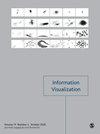1996-2016年《生态学杂志》上的数据和视觉显示
IF 2
4区 计算机科学
Q3 COMPUTER SCIENCE, SOFTWARE ENGINEERING
引用次数: 1
摘要
科学学科的学者在创建可视化方面面临着独特的挑战,尤其是在需要从分析中获得见解才能直观显示的出版物中。关于可视化的文献描述了创建图形的不同技术和最佳实践。然而,这些技术尚未用于评估学术出版物中可视化的影响。在生态学领域,与其他科学领域一样,图表是期刊文章的重要组成部分。对于所呈现的数据类型和研究人员进行研究的领域之间的联系知之甚少,这些领域共同产生了视觉图形。这项研究的重点是1996年至2016年间发表在《生态学杂志》上的文章,以探索数据类型、领域和可视化类型之间的可能联系。具体而言,这项研究提出了三个问题:在1996年至2016年间发布的图表中,有多少遵循了一套特定的最佳实践建议?关于数据类型、研究领域和视觉显示之间的关系,Pearson相关性可以揭示什么?是否可以通过互可靠性测试来检查这些发现?在评估的20080个可视化中,54%在研究的早期(1996-2010)包含了不必要的图形元素。最常见的数据类型是单变量(35%),通常使用折线图显示。在研究期间,21%的文章可以归类为“单一物种”领域类型。Pearson相关分析表明,数据类型和领域类型呈正相关(r = 0.08;p ≤ 0.05)。Cohen’s kappa的可靠性测试为0.86,表明两个类别之间存在良好的一致性。这项研究提供了证据,证明数据类型和领域类型在确定科学期刊上的可视化类型方面同样重要。本文章由计算机程序翻译,如有差异,请以英文原文为准。
Data and visual displays in the Journal of Ecology 1996–2016
Scholars in scientific disciplines face unique challenges in the creation of visualizations, especially in publications that require insights derived from analyses to be visually displayed. The literature on visualizations describes different techniques and best practices for the creation of graphs. However, these techniques have not been used to evaluate the impact of visualizations in academic publications. In the field of ecology, as in other scientific fields, graphs are an essential part of journal articles. Little is known about the connections between the kind of data presented and domain in which the researchers conducted their study that together produces the visual graphics. This study focused on articles published in the Journal of Ecology between 1996 and 2016 to explore possible connections between data type, domain, and visualization type. Specifically, this study asked three questions: How many of the graphics published between 1996 and 2016 follow a particular set of recommendations for best practices? What can Pearson correlations reveal about the relationships between type of data, domain of study, and visual displays? Can the findings be examined through an inter-reliability test lens? Out of the 20,080 visualizations assessed, 54% included unnecessary graphical elements in the early part of the study (1996–2010). The most common type of data was univariate (35%) and it was often displayed using line graphs. Twenty-one percent of the articles in the period studied could be categorized under the domain type “single species.” Pearson correlation analysis showed that data type and domain type was positively correlated (r = 0.08; p ≤ 0.05). Cohen’s kappa for the reliability test was 0.86, suggesting good agreement between the two categories. This study provides evidence that data type and domain types are equally important in determining the type of visualizations found in scientific journals.
求助全文
通过发布文献求助,成功后即可免费获取论文全文。
去求助
来源期刊

Information Visualization
COMPUTER SCIENCE, SOFTWARE ENGINEERING-
CiteScore
5.40
自引率
0.00%
发文量
16
审稿时长
>12 weeks
期刊介绍:
Information Visualization is essential reading for researchers and practitioners of information visualization and is of interest to computer scientists and data analysts working on related specialisms. This journal is an international, peer-reviewed journal publishing articles on fundamental research and applications of information visualization. The journal acts as a dedicated forum for the theories, methodologies, techniques and evaluations of information visualization and its applications.
The journal is a core vehicle for developing a generic research agenda for the field by identifying and developing the unique and significant aspects of information visualization. Emphasis is placed on interdisciplinary material and on the close connection between theory and practice.
This journal is a member of the Committee on Publication Ethics (COPE).
 求助内容:
求助内容: 应助结果提醒方式:
应助结果提醒方式:


